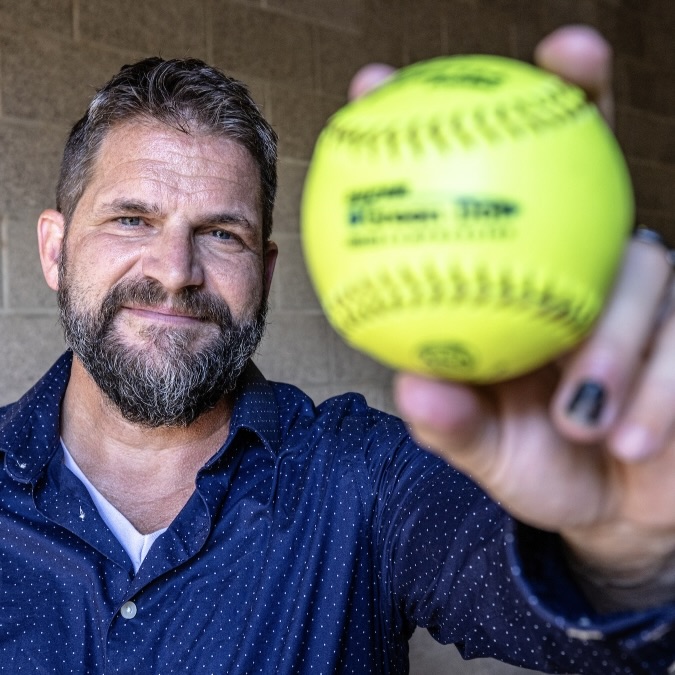“Steph Curry never shoots the same jump shot twice. It’s his ability to adapt that makes him a great shooter.”
Dr. Rob Gray
What You will learn
- Adaptability over Repetition: True skill development comes from practicing under varied conditions that mimic real-world scenarios, helping athletes adapt to different challenges on the field or court.
- Guide, Don’t Instruct: Coaches should create environments that encourage athletes to explore solutions to movement challenges on their own, helping them become more self-sufficient and creative in their performance.
- Learning Takes Time: The path to mastery is not a straight line; athletes must embrace the ups and downs of skill development, knowing that persistence through challenges is key to long-term success.
In this enlightening episode of The Finding Small Wins Podcast, host Dr. Adam Loiacono sits down with Dr. Rob Gray, an expert in motor learning, skill acquisition, and ecological dynamics. Rob shares groundbreaking insights on how we learn to move and perform in sports, making this episode a must-listen for anyone in coaching, therapy, or athletics. From motor learning theories to practical strategies for improving athletic performance, Rob’s expertise offers a fresh perspective on how to develop adaptable and resilient athletes. Let’s dive into the key lessons from the episode and explore how you can apply them in your own practice.
Who is Dr. Rob Gray?
Dr. Rob Gray is a professor, author, and the host of the Perception & Action Podcast, where he discusses the science behind motor learning and performance. With over 25 years of experience, Rob has worked with elite sports teams, including MLB and NBA franchises, helping them optimize performance through a better understanding of skill acquisition and motor learning. His book, How We Learn to Move, has become a staple for coaches and practitioners looking to deepen their knowledge in these fields.
In this episode, Rob explains the importance of perception, variability in training, and how the constraints-led approach can revolutionize how we coach and teach athletes.
Motor Skill Acquisition: It’s Not Just Repetition
One of the key points Rob makes is that motor skill acquisition isn’t about mindless repetition. Traditionally, athletes have been told that perfect practice makes perfect, but Rob challenges this idea. According to his research, adaptability is more important than repeating the same movement over and over.
In this context, repetition without variability can limit an athlete’s ability to adjust to changing game conditions. Rob emphasizes that skill acquisition should focus on repeating the outcome, not the exact movement.
The Role of Perception in Performance
Perception is critical in sports performance. Rob explains that what we see, feel, or sense from our environment drives every movement we make. Whether it’s judging the distance to the basket in basketball or assessing a gap between players in soccer, perception allows athletes to make real-time decisions.
This insight reinforces the need to create practice environments that simulate the complexity of real games, so athletes can fine-tune their perceptual abilities.
“All of our actions are driven by what information we perceive in the environment.”
Ecological Dynamics: Embracing Variability
Rob introduces the concept of ecological dynamics, which shifts the focus from mastering a single ideal movement to learning how to adapt movements to different conditions. In his view, athletes should be exposed to a variety of scenarios in training to build functional variability.
By practicing under varying conditions, athletes can learn to solve movement problems in real-time, which prepares them for the unpredictable nature of competition.
“Repetition without repetition—keep achieving the same outcome but vary how you get there.”
The Constraints-Led Approach: Guiding, Not Instructing
The constraints-led approach is a revolutionary method in coaching that focuses on modifying the environment to guide athletes toward discovering their own movement solutions. Instead of giving explicit instructions, coaches should set up constraints (like rules or equipment modifications) that encourage athletes to explore different movement strategies.
For example, instead of telling a basketball player exactly how to shoot, a coach might introduce a defender or alter the shooting conditions to force the player to adapt.
“The constraints-led approach encourages athletes to explore and find their own solutions to movement challenges.”
The Role of the Coach: From Instructor to Guide
Rob emphasizes that the role of the coach is evolving. Rather than simply telling athletes what to do, coaches should act as guides, helping athletes find the movement solutions that work best for them. This approach allows athletes to develop their skills more naturally and fosters a deeper understanding of movement.
“We need to move away from over-instructing and start guiding athletes to discover what works for them.”
The Myth of Muscle Memory
The idea of “muscle memory” is commonly misunderstood. Rob explains that movement is not stored in the muscles; instead, the body adapts to the environment and task demands. Athletes need to build adaptable movement patterns, not rigid ones. This understanding changes how we approach repetition and variability in training.
“We don’t store a perfect movement—we adapt to whatever the situation requires.”
Skill Development in Team Practices
Rob discusses how team practices should balance skill development with game preparation. Early in a practice, athletes should be challenged with high-variability drills that encourage exploration and adaptability. As game day approaches, practice should shift to focus on building confidence and preparing for the specific challenges of the upcoming opponent.
“You want people making mistakes early in practice because that’s where the learning happens.”
Return to Play: Reintroducing Variability
In return-to-play scenarios, Rob emphasizes the importance of gradually reintroducing variability in movement to reduce the risk of reinjury. For example, a baseball player recovering from a UCL injury might begin with controlled throws before progressing to full-speed pitching. By carefully managing the constraints and variability, athletes can return to play stronger and more resilient.
“Return to play is not just about regaining strength—it’s about rebuilding adaptability.”
Building Psychological Safety
Rob also touches on the importance of creating a team culture where athletes feel safe to explore and make mistakes. Psychological safety is crucial for fostering an environment where learning and growth can happen. Creating this environment allows athletes to push their boundaries without fear of failure.
“If athletes are afraid of making mistakes, they won’t explore new ways of moving, which limits their development.”
Learning Isn’t Linear
One of the most important lessons Rob shares is that learning is not a straight line. Athletes will have ups and downs, and it’s important to stay the course even when immediate progress isn’t visible. This mindset encourages patience and persistence in both coaches and athletes.
“Learning doesn’t happen in a nice straight line—there are ups, downs, and plateaus along the way.”
Conclusion
The insights shared by Dr. Rob Gray in this episode of The Finding Small Wins Podcast provide a fresh perspective on motor learning and skill acquisition. Whether you’re a coach, athlete, or therapist, adopting these principles can help you foster adaptability, resilience, and long-term success in sports.
Want to Learn more from Rob Gray?
- Visit Rob’s website for more insights on motor learning and coaching: PerceptionAction.com
- Follow Rob on Instagram for daily updates and tips: @robgray
- Sign up for Rob’s upcoming course in November on ecological coaching and skill acquisition. Don’t miss out on this game-changing opportunity to learn from one of the best in the field!
Listen here – Finding Small Wins Podcast:
Dr. Rob Gray: The Ecological Approach to Skill Acquisition
10 Key Takeaways
- Motor skill acquisition is about adaptability, not just repetition: Athletes develop real skill by learning to adapt their movements to different situations and conditions, rather than just repeating the same movement over and over again.
- Perception is essential for driving movement decisions in sports: What athletes perceive in their environment, such as the positioning of opponents or the distance to a target, determines the actions they take, making perception a fundamental part of performance.
- Ecological dynamics encourage athletes to adapt to changing environments: This approach teaches athletes to perform well under a variety of conditions by practicing with different constraints, helping them become more versatile and resilient.
- The constraints-led approach guides athletes toward discovering their own movement solutions: By modifying training environments or setting rules, coaches can encourage athletes to find unique, personal solutions to movement challenges, improving both performance and creativity.
- Coaches should act as guides, not instructors, to help athletes develop adaptable skills: Instead of simply giving instructions, coaches should create environments that allow athletes to explore and learn from their mistakes, fostering independence and self-reliance.
- Muscle memory is a myth—movement is adaptable, not stored: Rather than storing perfect movements in memory, athletes continuously adapt to their current physical state and environmental conditions, making them more capable of handling real-world challenges.
- Skill development in team practices should include high-variability drills early on: Introducing challenging and varied drills early in practice helps athletes develop problem-solving abilities that will transfer to unpredictable game situations.
- Return-to-play protocols must include variability to avoid reinjury: In order to safely return an athlete to competition, rehab should involve varying degrees of movement and stress, gradually building up adaptability and resilience to prevent re-injury.
- Psychological safety is critical for encouraging athletes to explore and take risks: Creating an environment where athletes feel comfortable making mistakes allows them to fully engage in learning and explore new ways of performing without fear of failure.
- Learning is not linear—there will be ups and downs, but persistence leads to success: Skill development doesn’t follow a smooth, upward trajectory; athletes will experience plateaus and regressions, but consistent effort and practice will eventually lead to improvement.
episode timeline
00:00 – 03:00: Introduction and Rob Gray’s background
03:00 – 07:00: Motor skill acquisition and repetition
07:00 – 12:00: Perception in sports and movement
12:00 – 18:00: The 10×10 sprint protocol and its evolution
18:00 – 21:00: Adjusting 10×10 for different athletes
21:00 – 26:00: Return-to-play strategies
26:00 – 30:00: The constraints-led approach
30:00 – 35:00: Skill development in team practices
35:00 – 41:00: Balancing game preparation with skill development
41:00 – End: Conclusion and Rob’s upcoming book and course



